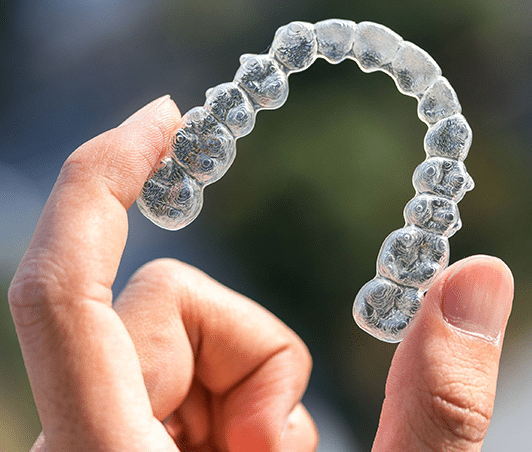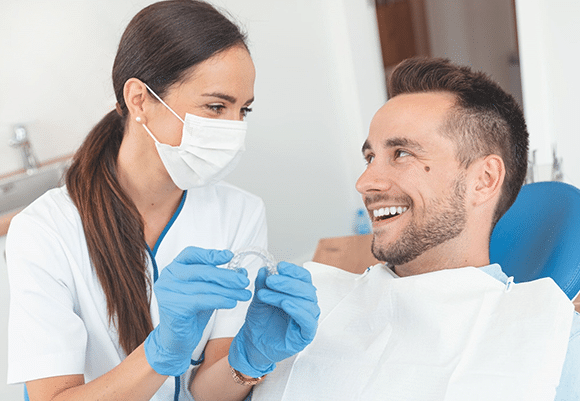(707) 622-6748

Appearance is not the only benefit of wearing Invisalign® for straighter teeth, since straighter teeth can also benefit one's oral health. In fact crooked teeth can trap food between them and lead to infection or bite issues. At Graton Dental Group, we offer Invisalign® as a treatment for patients interested in discreetly straightening their teeth.
Invisalign® is a series of clear aligner trays that cover the teeth, similar to a retainer or mouth guard, but are much more discreet. At least every two weeks or so, the patient will switch to the next set in the series of Invisalign trays. With the custom aligners for each patient, Invisalign® will gradually push the teeth into the right position without causing significant amounts of pain.
The process
To begin, we will need to conduct a consultation and examination. This examination will involve reviewing the patient's medical history, current state of health, any pre-existing conditions or prescribed medications we need to know about and the position of the patient's teeth. We will then take a mold of the patient's teeth and measurements. With all of this information, we will send it to the lab to create the Invisalign® trays.
After creating the trays, we will then meet with the patient to ensure that they fit and that the patient understands all of the steps in the straightening process. It is important that the patient understand a few key factors about wearing Invisalign® on a regular basis.
Wearing the aligners for at least 22 hours per day
While the patient can remove Invisalign® trays when necessary, the patient will want to keep them in as much as possible. The longer the patient does not wear the trays for, the longer the entire process will take. Patients need to remove the aligner trays when eating and to brush the teeth.
Patients can also remove the aligner trays to play in a sports game, give a presentation, go on a date, or while taking a photo. It is important to at least rinse the mouth after eating to keep food from getting caught in the teeth.

Staying on schedule
Since we do not need to adjust Invisalign® aligners at our office as one might need to adjust braces, patients do not need to make as many checkup appointments. In fact, by customizing the aligner trays, we do not need to have the patient come in for regular orthodontic checkups.
The patient will be able to continue through each aligner tray and follow a schedule with no surprises. By following the schedule, the patient's teeth will continue to move into the proper position without pain.

Keep up regular oral hygiene
While wearing Invisalign®, patients will not have to brush and floss between brackets with difficulty. In fact, the patient will be able to brush and floss as normal by just removing the aligner trays. However, it is crucial that the patient brush after each meal to keep food from sticking between the teeth.
Food that is stuck in the teeth can also damage the aligners. It is important that patients do not wear the aligners while drinking soda or other beverages while wearing Invisalign® aligners. We recommend that patients only keep the aligners in when drinking water.
Customized for your teeth
We customize the Invisalign® aligners to fit the patient's teeth and then use programming technology to digitally map out the projected rate of movement for the patient. We will then build the rest of the clear aligners in the series. Each new set of aligners will be a bit closer to the correct position for straight teeth.
With a customized straightening treatment, patients do not need to worry about the aligners falling out or being loose. Since there is no one-size-fits-all treatment, we make sure that the trays are the right fit for each patient.
Discreet, efficient and easy to use
Invisalign® aligner trays are nearly invisible to the point that few people will notice them unless the individual mentions wearing them. Patients will not have to feel embarrassed by wearing traditional metal braces or a mess of wires in their mouth on a regular basis. Invisalign® allows for the patient to receive the straight smile they desire without the maintenance of going through braces treatment.
Patients will be able to feel confident in their smile during the straightening process. If you are interested in Invisalign® treatment, give us a call today and schedule an appointment. We will help you obtain the straight smile you have always wanted.
How do I get started with Invisalign®?
Definition of Invisalign® Terminology
Aligner Trays
Blue Compliance Indicator (Invisalign® Teen)
ClinCheck® Software
Gum Line
Incisal Ridges
iTero Element® Scanner
Malocclusion
Overbite
Polyurethane Resin
SmartForce Attachments
Smart Track® Material
Smile-Scan
Vivera® Retainers
Helpful Related Links
American Dental Association (ADA). Glossary of Dental Terms. 2015
American Academy of Cosmetic Dentistry® (AACD). Home Page. 2015
WebMD. WebMD’s Oral Care Guide. 2015
About our business, license, and website security
Graton Dental Group was established in 2017.
We accept the following payment methods: American Express, Cash, Check, Discover, MasterCard, and Visa
We serve patients from the following counties: Sonoma County
We serve patients from the following cities: Rohnert Park, Petaluma and Santa Rosa
CA (License #57545). View License Information and Specifics
National Provider Identifier Database (1376792994). View NPI Registry Information
Norton Safe Web. View Details
Trend Micro Site Safety Center. View Details

